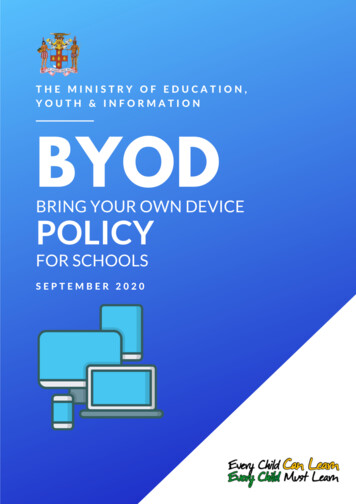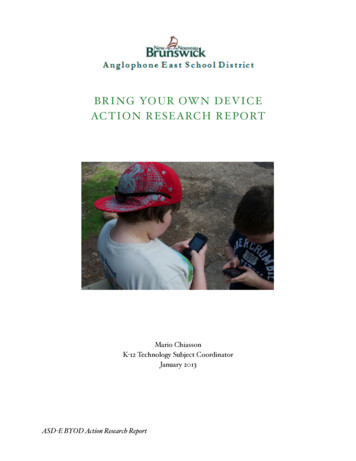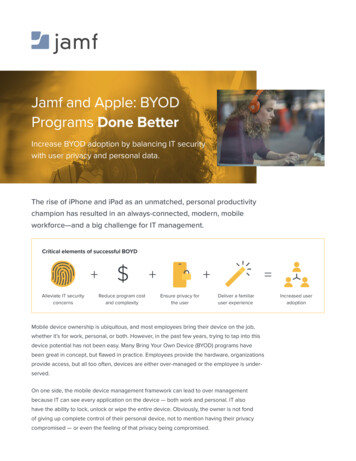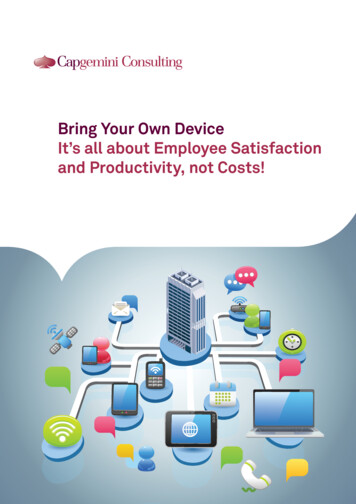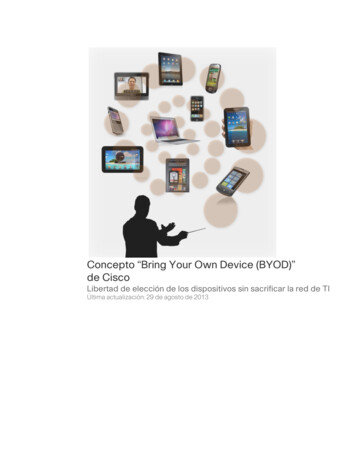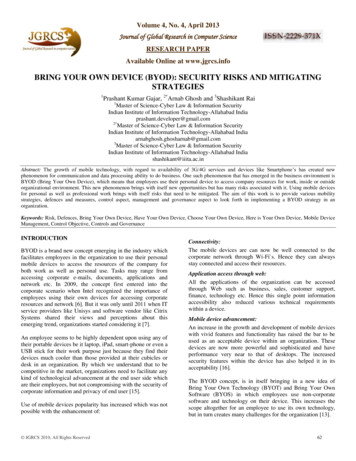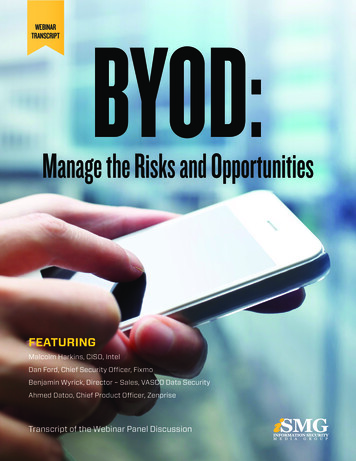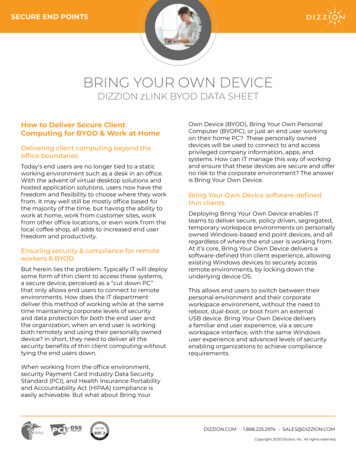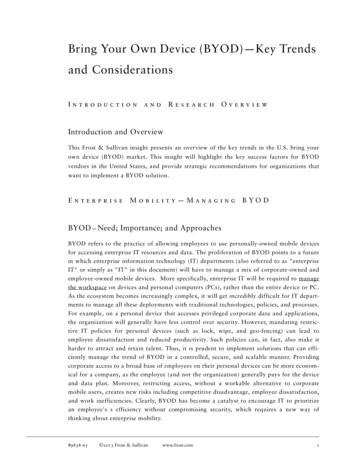
Transcription
Bring Your Own Device (BYOD)—Key Trendsand duction and OverviewThis Frost & Sullivan insight presents an overview of the key trends in the U.S. bring yourown device (BYOD) market. This insight will highlight the key success factors for BYODvendors in the United States, and provide strategic recommendations for organizations thatwant to implement a BYOD solution.EnterpriseMobility—ManagingBYODBYOD — Need; Importance; and ApproachesBYOD refers to the practice of allowing employees to use personally-owned mobile devicesfor accessing enterprise IT resources and data. The proliferation of BYOD points to a futurein which enterprise information technology (IT) departments (also referred to as "enterpriseIT" or simply as "IT" in this document) will have to manage a mix of corporate-owned andemployee-owned mobile devices. More specifically, enterprise IT will be required to managethe workspace on devices and personal computers (PCs), rather than the entire device or PC.As the ecosystem becomes increasingly complex, it will get incredibly difficult for IT departments to manage all these deployments with traditional technologies, policies, and processes.For example, on a personal device that accesses privileged corporate data and applications,the organization will generally have less control over security. However, mandating restrictive IT policies for personal devices (such as lock, wipe, and geo-fencing) can lead toemployee dissatisfaction and reduced productivity. Such policies can, in fact, also make itharder to attract and retain talent. Thus, it is prudent to implement solutions that can efficiently manage the trend of BYOD in a controlled, secure, and scalable manner. Providingcorporate access to a broad base of employees on their personal devices can be more economical for a company, as the employee (and not the organization) generally pays for the deviceand data plan. Moreover, restricting access, without a workable alternative to corporatemobile users, creates new risks including competitive disadvantage, employee dissatisfaction,and work inefficiencies. Clearly, BYOD has become a catalyst to encourage IT to prioritizean employee's s efficiency without compromising security, which requires a new way ofthinking about enterprise mobility.#9838-65 2013 Frost & Sullivanwww.frost.com1
Exhibit 1 shows the percent of organizations with BYOD activity in the United States from2011 to 2018.Exhibit 1BYOD—Key Trends and Considerations: Percent of Organizations with BYOD Activity,United States, 2011-201880.0070.82Organizations with BYOD 120142015YearNote: All figures are rounded; the base year is 2012. Source: Frost & SullivanExhibit 2 shows the top enterprise IT challenges for enterprise mobility management in theUnited States in 2013.Exhibit 2BYOD—Key Trends and Considerations: Top Enterprise IT Challenges for EnterpriseMobility Management, United States, 2013Source: Frost & Sullivan#9838-65 2013 Frost & Sullivanwww.frost.com2
It is extremely likely that more personal (or personally liable) mobile devices will accessenterprise IT resources than corporate owned (or corporate liable) devices within the nextfew years in the United States. However, BYOD is just one component of the broad enterprisemobility equation. According to Frost & Sullivan, enterprise mobility management is aboutenabling, securing, monitoring, and supporting enterprise mobile users, devices, content andapplications, while considering relevant parameters such as device fragmentation, globalization, and BYOD.Exhibit 3 shows the key elements of enterprise mobility management in the United States in2013.Exhibit 3BYOD—Key Trends and Considerations: Key Elements of Enterprise Mobility Management,United States, 2013Source: Frost & Sullivan#9838-65 2013 Frost & Sullivanwww.frost.com3
Confusing OptionsExtending the corporate IT environment to mobile devices helps improve worker productivity, improve supply chain operations, ensure faster and more efficient business hcustomers,partnersandsuppliers.Frost & Sullivan firmly believes that organizations leveraging mobility to manage the shift toa "virtual enterprise" framework will see increased efficiencies and operational advantages intheir respective industry verticals. Yet, determining the right solution to manage all aspects ofenterprise mobility can be a challenge. Enterprise IT is expected to: 1) give access to corporate IT resources to authorized users on personal mobile devices; 2) ensure that corporatenetwork, data, and applications are secure and are not misused or shared inappropriately;and 3) respect the users' privacy. There are various device-level and network-level technologies that can be used to manage BYOD programs, including: Mobile device management (MDM)—for centralized management and role-basedadministration of mobile devices in the enterprise. Container-based solutions—to deliver greater control over secure email and datacommunication in an organization. Type 1 and type 2 hypervisors—leverage virtual machines to provide secure enterprisedomains on mobile devices. Wireless Access Point (WAP)—simple mechanism to offer controlled (or limited) access tonetwork resources. Network access control (NAC)—primarily network-based solutions to define andimplement policy-based access to enterprise I.T. resources. Dual persona—separation of mobile devices into personal and secure enterprise modes. Custom mobile applications—custom or customized third-party applications to enablesecure communication and collaboration with remote workers on their mobile devices.Organizations need to be totally clear on the end goal of their mobile business strategy; theyneed to clearly define the business objectives and impact of mobility before taking a closerlook at specific BYOD management products. A thorough analysis of product capabilities,product deployment and support options, and total cost of ownership can help businessorganizations identify the right set of solutions that best meet their requirements. Evolvingsecurity, operational, and legal considerations also make it important to constantly evaluatehow best to implement mobility in the enterprise. Solutions that don't infringe on employees'privacy yet can ensure that corporate applications (and corporate data) are secure andprotected are more likely to be accepted by the corporate workforce.#9838-65 2013 Frost & Sullivanwww.frost.com4
Role and Importance of ContainersEffective BYOD implementations enable corporate IT to create, secure, manage, and monitora virtual corporate "persona" on personal mobile devices. A protected corporate workspace—also loosely referred to as a "container"—allows access to enterprise IT resourcesfrom within this secure mode. Appropriate corporate policies are defined to control what theuser can or cannot do within the container. Additionally, containers can be designed to notallow any potential malware that might exist on the personal side of the device to make wayinto the corporate persona (residing inside the container) on the same device. Mostcontainers include a secure email application (or application interface), and may also includeother mobile productivity tools such as a secure browser, and document viewer and editor.Leading providers of device containers also provide software development kits (SDKs), and"wrapper" codes to allow organizations to use in-house as well as commonly availablethird-party mobile applications for various organizational communication and collaborationrequirements. In certain cases, a wrapper might prove to be a better approach than a SDK,since it can be difficult for software vendors to re-compile their apps with SDKs. On theother hand, certain types of wrappers may not be approved for use in certain environments(such as Apple's iOS), which makes the SDK approach the only option. Even though therecould be some limitations in terms of granularity of information that could be obtained viacertain lightweight wrapper implementations (such as lack of insight into aspects as telecomusage, data usage, and how often are users using certain menu options), all leading BYODsolution vendors consider wrappers as an effective long-term strategy for increasing theirmarket reach.It should be noted that the term "container" is very broad and used quite loosely in theindustry. Containers are means to an end, "end" being to provide proper features to manageBYOD—including authorization, authentication, configuration, encryption, tunneling, DLPcontrols, analytics, and selective wipe.Types of ContainersContainers can be monolithic, which means all enterprise applications are wrapped inside aprotective application (the container).There can also be multiple app-level connectedcontainers that exist on a mobile device where each application is secured and each can sharedata and policy only with other secure apps. While there are pros and cons of a "captive"(every enterprise app is in a single container) versus an "integrated" (multiple separate appexperience on the device) user experiences for BYOD, it will ultimately come down to thepreference of the users. What is clear, however, is that containers have become critical tomanaging a successful BYOD program. This is more evident in regulated industries such asHealthcare and Financial Services, as well as for senior-level executive across multipleindustry segments. "Securing the Mobile Experience with Containers", a strategic analysis byMichael Suby of Stratecast (a division of Frost & Sullivan), presents additional details on thetypes, importance, and future of mobile containers.#9838-65 2013 Frost & Sullivanwww.frost.com5
Exhibit 4 shows a simplistic representation of a container on a mobile device in theUnited States in 2013.Exhibit 4BYOD—Key Trends and Considerations: A Simplistic Representation of a Container on aMobile Device, United States, 2013Corporate Applications andDataThat can be unlocked via a PINSecure Digital LockerTo access corporate applications and dataA secure location in mobiledevicesSource: Frost & SullivanThe Web vs. the App DebateAdvancement in web technologies can have serious implications for enterprise mobility andBYOD programs. It is generally simpler to maintain, upgrade, and distribute simple webapps. Web apps can be wrapped within a native app container as well (which then appear asnative apps to the user for all practical purposes). A well-designed web app that has no localstorage can help protect against the threat of mobile malware or a lost/stolen device withdata left on it. However, from a user experience perspective, a native app might be a betteroption. Any long-term corporate BYOD policy has to consider the possible emergence ofmobile web-driven enterprise mobility service architecture, and provide solutions to enablethe enterprise IT to manage the user and the device behavior in a HTML 5 (or other) webtechnologies driven information flow. Every IT department needs to be prepared for a mixedapplication environment consisting of native, web, and hybrid applications. This is wherehaving appropriate network-level control (versus having only device-level protection) toensure that all network traffic is monitored and managed in a secure manner could prove tobe valuable.#9838-65 2013 Frost & Sullivanwww.frost.com6
To pEnterpriseConcernswithBYODSecurity Concerns — Enterprise Data ProtectionEmployees feel more empowered with their smartphones and Tablets and are likely to findways to make mobile work for them, including using third-party apps and cloud services toget their work done. Well-intentioned employee behavior (such as forwarding email orstoring a document in the cloud), malware, lost devices, and compromised devices can allpose significant risks to enterprise security. Simple technologies such as copy-paste or evenspeech-to-text programs could result in inappropriate data usage. Today's connected workforce believes in the "everything is public unless stated otherwise" paradigm, whiletraditional corporate IT has worked along the lines of the "everything is private unless statedotherwise" rule. Protection of data in transmission, and protection of data that is stored onpersonal (or on corporate-owned) mobile devices are both extremely important for organizations. Proper BYOD tools, along with employee training programs should be used to helpenterprise IT guide, educate, and help their mobile workforce. This can help to reduce the"wild west" of applications and cloud services that can exist in an organization that choosesto ignore the trend of BYOD.Security Concerns — Enterprise Network ProtectionImplementing policy-based access to network resources is critical for corporate networksecurity. The real issues of data loss could very well be server-targeted, since that is where the"big data" really resides. It could be argued that with MDM (or BYOD) implementations,there is a reasonable degree of security that is ensured on the mobile devices, or at the veryminimum, the corporate side of the mobile device. However, malicious programs can stillreside on the unprotected mobile device, and make their way into the enterprise environment.Similarly, devices that don't have the latest software or firmware versions may try to accessthe corporate IT environment, and should be first updated before access is provided. Finally,there is always the risk of unmanaged and unprotected personally-liable device attempting toaccess corporate IT resources. As any experienced security professional knows, a tiered security architecture that focuses on protecting both the device as well as the network side of acorporate IT network is an extremely effective approach for network security. Network-sideincident prevention and remediation solutions don't face the constraints of a limited powersupply (as is the case with device-side protection tools) and can—at a very minimum—protect the network (and the data that resides in the network). Frost & Sullivan firmlybelieves that adopting a device-centric as well as a network-centric view of security forBYOD is critical to deliver complete peace of mind to enterprise IT.#9838-65 2013 Frost & Sullivanwww.frost.com7
Exhibit 5 shows the role and importance of device-based and network-based security controlsfor enterprise mobility management in the United States in 2013.Exhibit 5BYOD—Key Trends and Considerations: Role and Importance of Device-based andNetwork-based Security Controls for Enterprise Mobility management, United States, 2013Source: ForeScout Technologies Inc., Frost & SullivanTraditionally, IT security managers have installed network security, PC security, and datasecurity solutions. The migration away from corporate-owned PCs to personally-ownedendpoint devices does not remove the obligation to protect all three entities—the network,the device, and the data.#9838-65 2013 Frost & Sullivanwww.frost.com8
Legal ImplicationsSome top legal concerns with BYOD include: Ownership for intellectual property (IP) created on personal devices—does the employeeown the IP, or does the organization own the IP? Ensuring user (and data) privacy—to what extent should the usage patterns bemonitored? Loss of IP from personal mobile device—loss of company data, loss of customer data,and loss of IP created on personal devices: who is liable—employee or the organization? Defining appropriate processes for incident response and device remediation—can theorganization take control of the personal mobile device to ensure compliance? Liability for possible device software (or hardware) issues when personal devices are usedfor corporate work—will that amount of snooping on personal mobile devices? Potential liability for lost personal data (such as photos, contacts, documents)—when anorganizations ends up fully wiping a BYOD device.Organizations have to ensure that their acceptable use policy (AUP) are well defined and areclearly understood by corporate users that want to use their personal devices in a corporateenvironment. Simply extending the existing AUP for corporate-owned mobile devices topersonal devices is clearly not a very practical approach.So what should the Corporate IT do?B Y O D —I m p o r t a n t C o n s i d e r a t i o n s f o r E n t e r p r i s e sThe following are some important considerations for organizations that want to embrace aBYOD program.#9838-65 2013 Frost & Sullivanwww.frost.com9
Mobility is an ally, a key business enabler, a strategic tool for competitive differentiation,and the future of enterprise communication. This point cannot be stressed enough.Organizations should, at the very minimum, deploy a pilot program to evaluate how toleverage the potential of BYOD. This can also help to understand the risks involved inBYOD, which, in turn, can help develop an effective BYOD policy. Forward thinkingorganizations will treat mobile as a core IT service and consider that mobility will spanall aspects of IT infrastructure, technology processes, and service levels. Yet, in the shortand the mid-term, IT should leverage the established IT infrastructure as much aspossible to protect existing investments into the incumbent systems and platforms. BYOD, company-liable devices, cloud-based storage, and custom-built and third-partynative and web apps are the key drivers of the current revolution in enterprisecomputing. In the long-term, it is not unreasonable to expect tablet-only, smartphoneonly, or BYOD-only organizations in the United States. However, the mobile environmentpresents some unique challenges that go beyond just the technical aspects of BYOD. Asdiscussed earlier, there are other implications of BYOD (such as legal, andhuman-resources related) that have to be considered when implementing a BYODprogram. An effective BYOD policy can only be developed when different departmentswithin the organization—including finance and accounting, legal, HR, and operations—collaborate to design the correct BYOD framework. The importance of proper training to users cannot be overstated. Successfulorganizations will have trained users on what is/is not safe to do on their mobile devices,and what the rules are. Also as part of BYOD policy, IT doesn't need to say "yes" toeverything. It can create tiered policies based on job grades, OS types, apps, and otherparameters. For example, an organization may choose to provide core business apps onthe iOS platform, which limit BYOD access to only specific smartphone and tabletmodels. Corporate IT needs to take a long-term view of their mobility strategy. For example,organizations need to know how the traditional authentication and identity managementapproaches will evolve. New devices quickly make their way into the corporateenvironment in just a few days after their commercial release. BYOD vendors have toensure that they are ready to help their customers manage any new mobility platform thatcomes into the corporate environment. Implementing readily-available BYOD (andMDM) platforms offered by well-qualified vendors that have the necessary resources toinvest in product innovation is the right approach for any organization.#9838-65 2013 Frost & Sullivanwww.frost.com10
Organizations may still struggle to ensure up-to-date device protection for BYODdevices. Focusing only on device-level protection may not be sufficient to providecomplete protection against every possible security threat in BYOD. However,organizations usually always have a 100 percent control over their networks and shouldimplement a dynamic policy-based control system that can enforce which mobileendpoints can connect to which IT resources. Cost considerations, type of access controldesired by the organization, and extent of data protection mandated by law are someother factors that will eventually decide the security and compliance approach fororganizations. BYOD will lead to increased request for device configuration and support. IT shouldensure that users are able to use the existing helpdesk systems that support otherconnected endpoints (such as PCs) and enterprise apps. They also have to plan for thecost of increased requests, and should look to establish a tiered support modelcomprising of user self-service systems, as well as corporate helpdesk technologies andprocesses that require active participation of IT personnel. Even though BYOD means that organizations don't pay for devices, apps, or data, thereare other costs that may be incurred for enabling BYOD services. These may includeinvestments in infrastructure technologies that may need additional licensing, such asNAC, Identity Management, and VPN, as well as labor and support costs for theseimplementations. There is no "free lunch" with BYOD. A true ROI measurement forBYOD has to consider increase in employee productivity, increased revenues, impact ofemployee satisfaction, and potential for employee retention, as well as direct and indirectcost of BYOD implementation and management. Organizations should consider addressing the requirement of regulatory compliance inspecific verticals. For example, in the healthcare vertical, the Health Insurance Portabilityand Accountability Act (HIPPA) compliance related to rules for protection of individuallyidentifiable health information are applicable for encryption and protection of patientinformation on mobile devices. As organizations look to embrace a BYOD strategy, theyneed to ensure that the solutions they choose can deliver on various compliance-relatedrequirements, particularly related to data encryption, remote data wipe, and possibly theneed to ensure that business data is automatically wiped from personal devices after ithas been disconnected from the network for a certain period of time. Lastly, organizations have to ensure that they don't simply end up making it difficult toaccess corporate IT resources for their employees. Properly designed identify federationsolutions can help here, so can other related next-generation devices ,biometrics,audio-visualrecognition,location-based services, and other behavioral and contextual elements.#9838-65 2013 Frost & Sullivanwww.frost.com11
Enterprise Considerations for Selecting the Right Vendor – TheNon-technical SideSpecialized MDM vendors, mobile operators, traditional device security services providers,identity management providers, niche container-based solution providers, and organizationswith a hypervisor-based solution offer BYOD solutions. Technical capabilities alone may notbe sufficient to help identify the "best" solution for BYOD. The following strategic parameters should also be considered at when evaluating MDM/BYOD vendors. Platform extensibility, modularity, and roadmap- BYOD enables employees to select theirpreferred device and infers that the organization will have the ability to support it. Asenterprise requirements change and companies expand, their MDM solution should growwith them. At first, an enterprise may only be looking for base features such as remotelock and clear passcode. As the enterprise grows, application and content security maybecome more important. Also, enterprises should look for vendors that rapidly supportdevices as they are released. Security strategy—it is important to work with MDM/BYOD vendors that can providesecurity across multiple data types—email, email attachments, apps, content, web, etc.—for data at-rest and data in-motion. Security credentials—such as Federal InformationSecurity Management Act of 2002(FISMA) compliance, Federal Risk and on,CloudSecurityAlliance(CSA)certification, and Service Organization Control (SOC) reports—are important to considerparticularly for cloud-based BYOD solution providers. As discussed earlier, it isimportant to also evaluate different network monitoring, network protection, and policyimplementation tools that could work in conjunction with BYOD platforms. Approach to identify management—in a BYOD environment, identify really determinesthe types of services delivered. Delivering single sign on (SSO) services for enterprise weband native applications on the smaller screen mobile devices is important to deliver agood user experience on the small-screen mobile device. Enterprise may or may not havea public key infrastructure (PKI). BYOD vendors should be able to work in either case,and provide an embedded certificate authority and ongoing engineering investment (andtherefore a roadmap) around identity. Customer support capabilities—MDM vendors' investment in customer support systemsis indicative of the vendors' long-term commitment to the enterprise mobility market.Any technical issues should be resolved immediately.This can also be specified inappropriate service-level agreements (SLAs) offered by BYOD vendors. It's alsoimportant to remember that customer support isn't just about the system itself. Trainingmaterials, knowledge portals and self service portals are integral pieces of customersupport services as well.#9838-65 2013 Frost & Sullivanwww.frost.com12
Pricing strategy- low cost solutions may not be the best, especially when the stakes arehigh in BYOD. Low prices can help BYOD vendors win new deals, however; vendorsmust have the ability to invest in scaling and enhancing the capabilities of theirimplementations. It is therefore prudent to consider vendors with a significant customerbase, breadth of MDM capabilities, and large employee base dedicated to supportingBYOD. These types of characteristics validate the vendor's BYOD expertise. Preserving the user experience—the user experience should ideally never change with thesecurity implementation in place. For example, the on-device client should not consumetoo many processing resources and slow down the device. Users should not be forced toremember multiple passwords for different services that they want to access and use ontheir mobile devices. The intuitive user interface should ideally be maintained forenterprise mobility deployments, which will actually help make the workforce moreproductive. Simplicity and platform flexibility—a well-designed solution should be easy to use for ITadministrators as well as the end users. The platform also needs to be able to supportvarying use cases across business teams. For example, a MDM platform with true multitenancy allows executives to have different security settings and policies as compared tofield employees. In-house versus licensed technology—MDM/BYOD vendors can license core portions oftheir product (such as application wrapping) from other vendors. In certain cases, thesuccess of MDM/BYOD solution providers could depend upon the ability of technologyproviders to continue to innovate (since the technology itself needs to be upgradedfrequently), which may not happen if the technology provider gets acquired or goes outof business. However, rarely does a MDM/BYOD vendor have enough resources to buildeverything AND be the best at everything. This is particularly true in enterprise security,where it could be better to rely on proven security experts to provide thoroughly testedand effective implementations. Ensure that the organization is always in control—the enterprise mobility strategy shouldideally never be dictated (or limited) by the capabilities (or limitations) of the BYODplatform. The organization should have full control over the default system behavior andshould be able to define and control how it manages its BYOD implementation. Forexample, while a BYOD solution provider may offer several options to address the issueof jail broken devices—including blocking and/or removing all or specific applications orprofile types, and forcing a full device wipe or device check-in, it should be up to theorganization whether it wants to remove specific resources or do a full device wipe.#9838-65 2013 Frost & Sullivanwww.frost.com13
AFewOtherKeySuccessFactorsforBYODVe n d o rsPlatform ArchitectureFrost & Sullivan expects the enterprise segment to increasingly make long-term "strategic"decisions about the role of mobility in their IT programs. This will define the types of solutions, support, and customization capabilities that customers expect. Platform architecture,enterprise app strategy, and enterprise infrastructure strategy are the three important sets ofcapabilities for BYOD vendors.Important elements include the following: Ability to integrate with existing enterprise IT applications and systems—including emailprograms, collaboration tools (such as Microsoft SharePoint), and certificate authority.The solution must also integrate with Active Directory (for policy) and potentially otheridentity and access management systems. Ability to scale vertically and horizontally—ability to support new seats from within thesame application, and ability to support new corporate applications and services ifrequired. Platform extensibility—ability to develop new platform capabilities. This is also criticalto help support transformational business processes that help to make employees moreefficient in their work. A cloud-based solution with the right security capabilities canhelp address some of these challenges.Enterprise App StrategyBYOD vendors have to provide appropriate tools to allow organizations to leverage in-houseas well as third-party enterprise communication applications within their networks. BYODvendors' enterprise app strategy should consider the following:#9838-65 2013 Frost & Sullivanwww.frost.com14
Facilitating a collaborative enterprise app ecosystem—providing appropriate SDKs orwrapper solutions to third-party application providers to help them leverage BYODplatform services. BYOD vendors can consider strategic partnerships with leadin
and 3) respect the users' privacy. There are various device-level and network-level technolo-gies that can be used to manage BYOD programs, including: Mobile device management (MDM)—for centralized management and role-based administration of mobile devices in the enterprise.
